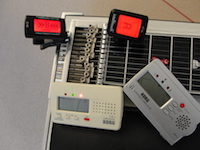
If you are new to steel guitar and have been looking for input on how to tune the E9 tuning, you may have discovered tempered tuning charts that show what strings to tune away from A-440 to get “in tune”. Then you tuned up and tried to play along with your band or a track and it just sounded “off”on some chords but not others. Let me try to help out here with a few ideas that are becoming more popular and accepted with the steel guitar community.
You are experiencing the effect of Just Intonation, which we will call JI ,versus Equal Temperament, or ET.
Equal Temperament is the division of the octave into twelve equal steps using a mathematical formula. ET has been the most common manner of tuning musical instruments for the last 300 years and can be found in modern music on most electric keyboard instruments as well as fretted stringed instruments such as guitar, ukulele, mandolin, and fretted basses. When you tune an instrument with a digital tuner and center each pitch to the zero position you have tuned to ET. But there are problems with this system. To some ears ET sounds harsh. Others hear beats in the chords and intervals that they find unacceptable.
Because the steel guitar has tremendous sustain and clarity of sound, it’s easy to hear “beats” when two strings are sounded together. If you tune your 8th string E to A-440 “straight up” on any of the common digital tuners and your 5th string B the same, they will sound pretty good together. But then you add the 6th or 3rd string G#’s and you will hear pulsing beats unless you tune the G#’s flat by anywhere from 5 to 15 cents. At that point you can play an E triad on strings 8, 6, and 5 and you will have a great sounding E chord. The steel is in tune with itself using Just Intonation. But play along with a fixed pitch instrument like a piano or guitar and it just doesn’t sound right. What happened? The A-440 ET notes on the fixed pitch instruments clashed with your temper-tuned JI notes on the steel! That would lead me to believe that we should tune “straight up” to A-440 so we can sound in tune with other instruments. Try it and see if it works for you. Physics guys have all sorts of fun with this concept. This is where you, the player, get to have your way. A good way to start is to tune all ET and see how it sounds. Give it awhile for your ears to adjust if this is a new thing for you. At first ET chords can sound harsh, but they match up well with other ET instruments, especially individual scale tones. On the other side of the discussion, JI chords sound smooth and work well if there are no other instruments that clash with the tempered notes. String ensembles and vocal groups often end up with JI. It’s hard to have it both ways.
One problem that makes JI difficult to use is the fact that notes that you tune away from ET are often used in other chords in other places in the inversion.
A classic case is the 5th string whole tone pull on the A pedal, which is flatted to become the 3rd tone, C#, in the A chord when the A and B pedal are used together. When you move the bar up three frets from the root position, no pedals, and use the A pedal and the F knee lever to get the next higher inversion the chord is massively out of tune unless the pull on the F lever is flatted a lot to fit with the new chord. That makes the F lever change useless for any other chord except that one.There are many more examples like this, and manufacturers have installed compensators to deal with each of these problems, but you may just end up chasing your tail trying to adjust for each problem chord
Check yourself by playing with other instruments if you can, or record yourself over a rhythm track and listen back to it. Remember, you still have to put the tone bar in the right place! Checking your bar placement with a tuner is helpful and reassuring. If you are playing with a group of musicians that are happy with the way you sound and YOU are happy with the way you sound, you are done. If you are in a recording environment a recording engineer or producer will have something to say about your sound. It can also be very useful to record yourself if you are playing live and listen back after a few days and see how you sound.
Be aware that some very famous pedal steel players have switched from JI to ET in their careers, so don’t be afraid to try it and give it a chance.
Since the pedal steel is not a solo instrument you need to fit in with the sounds around you. Sometimes that means playing different chord grips or string combinations than you would like to make your sound fit in.Not all instruments can match each other’s tones, even if they are tuned the same so listen and adjust. Making your sound mesh with the instruments around you is everything, so listen, experiment and adapt until you are happy with the sound of your musical voice.
One last note. If some of this is not working for you, change your strings! New strings are the best cure for bad tone.